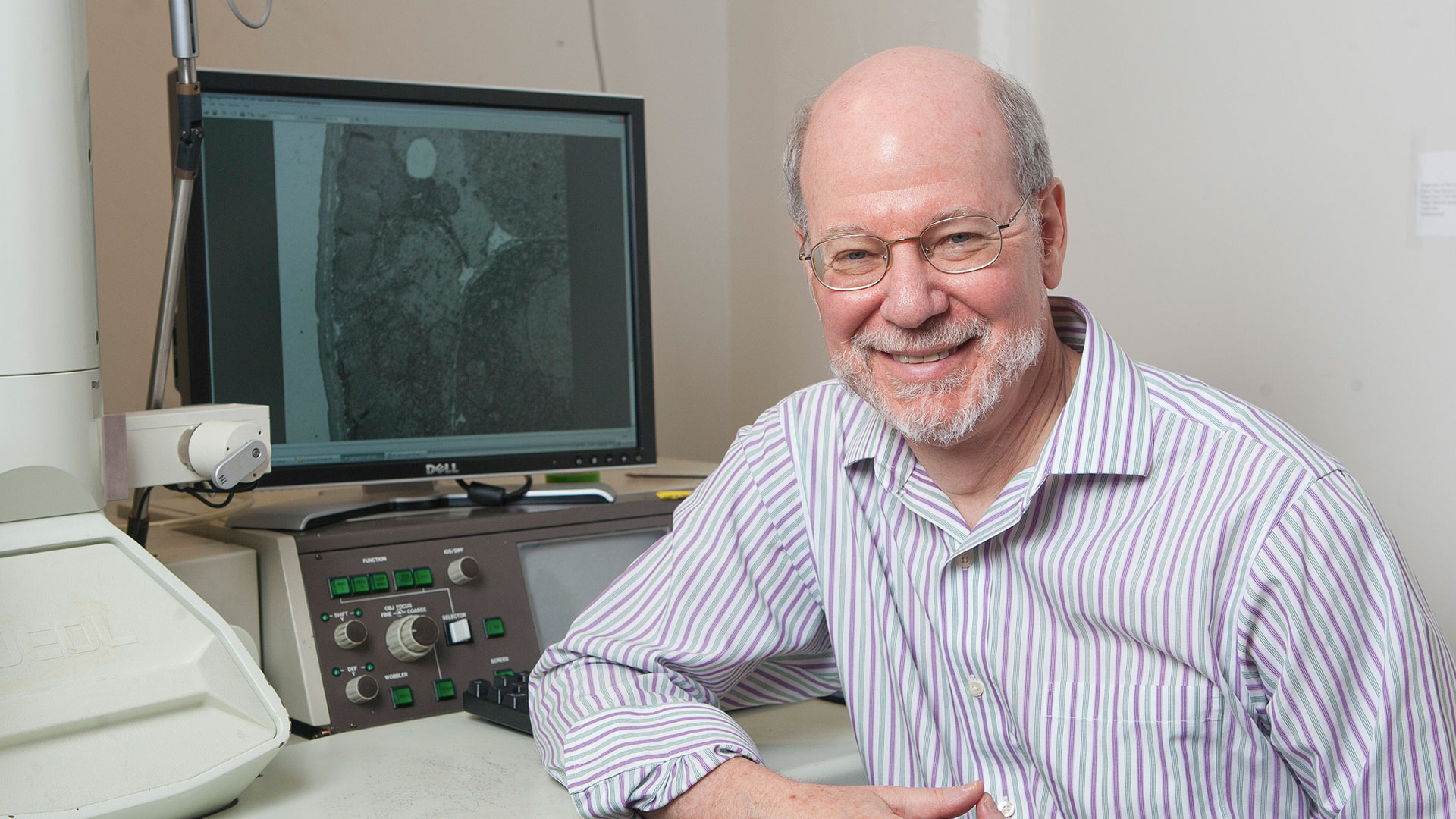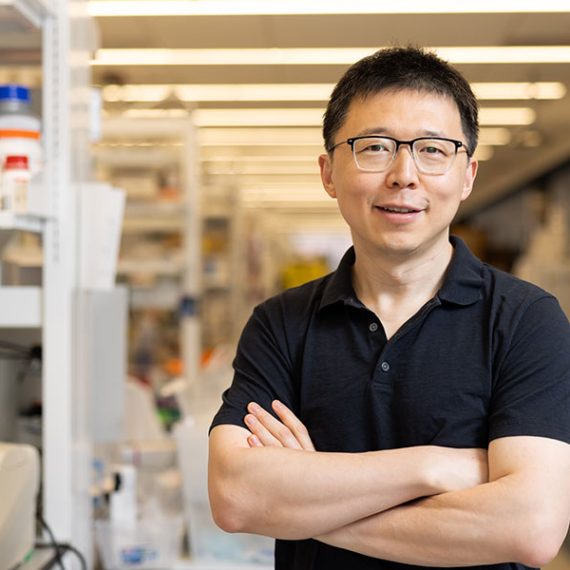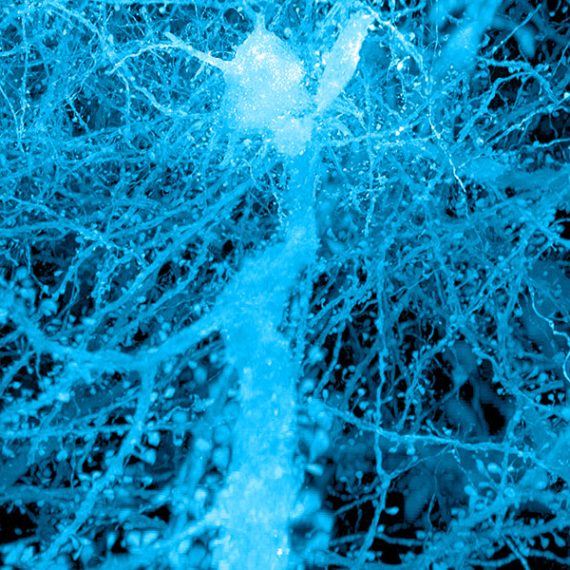From cancer to brain research: learning from worms
Bob Horvitz approaches science with patience and the confidence that he will find answers to big questions if he explores important problems in tractable ways.

In Bob Horvitz’s lab, students watch tiny worms as they wriggle under the microscope. Their tracks twist and turn in every direction, and to a casual observer the movements appear random. There is a pattern, however, and the animals’ movements change depending on their environment and recent experiences.
“A hungry worm is different from a well-fed worm,” says Horvitz, David H. Koch Professor of Biology and a McGovern Investigator. “If you consider worm psychology, it seems that the thing in life worms care most about is food.”
Horvitz’s work with the nematode worm Caenorhabditis elegans extends back to the mid-1970s. He was among the first to recognize the value of this microscopic organism as a model species for asking fundamental questions about biology and human disease.
The leap from worm to human might seem great and perilous, but in fact they share many fundamental biological mechanisms, one of which is programmed cell death, also known as apoptosis. Horvitz shared the Nobel Prize in Physiology or Medicine in 2002 for his studies of cell death, which is central to a wide variety of human diseases, including cancer and neurodegenerative disorders. He has continued to study the worm ever since, contributing to many areas of biology but with a particular emphasis on the nervous system and the control of behavior.
In a recently published study, the Horvitz lab has found another fundamental mechanism that likely is shared with mice and humans. The discovery began with an observation by former graduate student Beth Sawin as she watched worms searching for food. When a hungry worm detects a food source, it slows almost to a standstill, allowing it to remain close to the food.
Postdoctoral scientist Nick Paquin analyzed how a mutation in a gene called vps-50, causes worms to slow similarly even when they are well fed. It seemed that these mutant worms were failing to transition normally between the hungry and the well-fed state.
Paquin decided to study the gene further, in worms and also in mouse neurons, the latter in collaboration with Yasunobu Murata, a former research scientist in Martha Constantine-Paton’s lab at the McGovern Institute. The team, later joined by postdoctoral fellow Fernando Bustos in the Constantine-Paton lab, found that the VPS-50 protein controls the activity of synapses, the junctions between nerve cells. VPS-50 is involved in a process that acidifies synaptic vesicles, microscopic bubbles filled with neurotransmitters that are released from nerve terminals, sending signals to other nearby neurons.
If VPS-50 is missing, the vesicles do not mature properly and the signaling from neurons is abnormal. VPS-50 has remained relatively unchanged during evolution, and the mouse version can
substitute for the missing worm gene, indicating the worm and mouse proteins are similar not only in sequence but also in function. This might seem surprising given the wide gap between the tiny nervous system of the worm and the complex brains of mammals. But it is not surprising to Horvitz, who has committed about half of his lab resources to studying the worm’s nervous system and behavior.
“Our finding underscores something that I think is crucially important,” he says. “A lot of biology is conserved among organisms that appear superficially very different, which means that the
understanding and treatment of human diseases can be advanced by studies of simple organisms like worms.”
Human connections
In addition to its significance for normal synaptic function, the vps-50 gene might be important in autism spectrum disorder. Several autism patients have been described with deletions that include vps-50, and other lines of evidence also suggest a link to autism. “We think this is going to be a very important molecule in mammals,” says Constantine-Paton. “We’re now in a position to look into the function of vps-50 more deeply.”
Horvitz and Constantine-Paton are married, and they had chatted about vps-50 long before her lab began to study it. When it became clear that the mutation was affecting worm neurons in a novel way, it was a natural decision to collaborate and study the gene in mice. They are currently working to understand the role of VPS-50 in mammalian brain function, and to explore further the possible link to autism.
The day the worm turned
A latecomer to biology, Horvitz studied mathematics and economics as an undergraduate at MIT in the mid-1960s. During his last year, he took a few biology classes and then went on to earn
a doctoral degree in the field at Harvard University, working in the lab of James Watson (of double helix fame) and Walter Gilbert. In 1974, Horvitz moved to Cambridge, England, where he worked with Sydney Brenner and began his studies of the worm.
“Remarkably, all of my advisors, even my undergraduate advisor in economics here at MIT, Bob Solow, now have Nobel Prizes,” he notes.
The comment is matter-of-fact, and Horvitz is anything but pretentious. He thinks about both big questions and small experimental details and is always on the lookout for links between the
worm and human health.
“When someone in the lab finds something new, Bob is quick to ask if it relates to human disease,” says former graduate student Nikhil Bhatla. “We’re not thinking about that. We’re deep in
the nitty-gritty, but he’s directing us to potential collaborators who might help us make that link.”
This kind of mentoring, says Horvitz, has been his primary role since he joined the MIT faculty in 1978. He has trained many of the current leaders in the worm field, including Gary Ruvkun
and Victor Ambros, who shared the 2008 Lasker Award, Michael Hengartner, now President of the University of Zurich, and Cori Bargmann, who recently won the McGovern’s 2016 Scolnick Prize in Neuroscience.
“If the science we’ve done has been successful, it’s because I’ve been lucky to have outstanding young researchers as colleagues,” Horvitz says.
Before becoming a mentor, Horvitz had to become a scientist himself. At Harvard, he studied bacterial viruses and learned that even the simplest organisms could provide valuable insights about fundamental biological processes.
The move to Brenner’s lab in Cambridge was a natural step. A pioneer in the field of molecular biology, Brenner was also the driving force behind the adoption of C. elegans as a genetic model organism, which he advocated for its simplicity (adults have fewer than 1000 cells, and only 302 neurons) and short generation time (only three days). Working in Brenner’s lab, Horvitz
and his collaborator John Sulston traced the lineage of every body cell from fertilization to adulthood, showing that the sequence of cell divisions was the same in each individual animal. Their landmark study provided a foundation for the entire field. “They know all the cells in the worm. Every single one,” says Constantine-Paton. “So when they make a mutation and something is weird, they can determine precisely which cell or set of cells are affected. We can only dream of having such an understanding of a mammal.”
It is now known that the worm has about 20,000 genes, many of which are conserved in mammals including humans. In fact, in many cases, a cloned human gene can stand in for a missing
worm gene, as is the case for vps-50. As a result, the worm has been a powerful discovery machine for human biology. In the early years, though, many doubted whether worms would be relevant. Horvitz persisted undeterred, and in 1992 his conviction paid off, with the discovery of ced-9, a worm gene that regulates programmed cell death. A graduate student in Horvitz’ lab cloned ced-9 and saw that it resembled a human cancer gene called Bcl-2. They also showed that human Bcl-2 could substitute for a mutant ced-9 gene in the worm and concluded that the two genes have similar functions: ced-9 in worms protects healthy cells from death, and Bcl-2 in cancer patients protects cancerous cells from death, allowing them to multiply. “This was the moment we knew that the studies we’d been doing with C. elegans were going to be relevant to understanding human biology and disease,” says Horvitz.
Ten years later, in 2002, he was in the French Alps with Constantine-Paton and their daughter Alex attending a wedding, when they heard the news on the radio: He’d won a Nobel Prize, along with Brenner and Sulston. On the return trip, Alex, then 9 years old but never shy, asked for first-class upgrades at the airport; the agent compromised and gave them all upgrades to business class instead.
Discovery machine at work
Since the Nobel Prize, Horvitz has studied the nervous system using the same strategy that had been so successful in deciphering the mechanism of programmed cell death. His approach, he says, begins with traditional genetics. Researchers expose worms to mutagens and observe their behavior. When they see an interesting change, they identify the mutation and try to link the gene to the nervous system to understand how it affects behavior.
“We make no assumptions,” he says. “We let the animal tell us the answer.”
While Horvitz continues to demonstrate that basic research using simple organisms produces invaluable insights about human biology and health, there are other forces at work in his lab. Horvitz maintains a sense of wonder about life and is undaunted by big questions.
For instance, when Bhatla came to him wanting to look for evidence of consciousness in worms, Horvitz blinked but didn’t say no. The science Bhatla proposed was novel, and the question
was intriguing. Bhatla pursued it. But, he says, “It didn’t work.”
So Bhatla went back to the drawing board. During his earlier experiments, he had observed that worms would avoid light, a previously known behavior. But he also noticed that they immediately stopped feeding. The animals had provided a clue. Bhatla went on to discover that worms respond to light by producing hydrogen peroxide, which activates a taste receptor.
In a sense, worms taste light, a wonder of biology no one could have predicted.
Some years ago, the Horvitz lab made t-shirts displaying a quote from the philosopher Friedrich Nietzsche: “You have made your way from worm to man, and much within you is still worm.”
The words have become an informal lab motto, “truer than Nietzsche could everhave imagined,” says Horvitz. “There’s still so much mystery, particularly about the brain, and we are still learning from the worm.”




